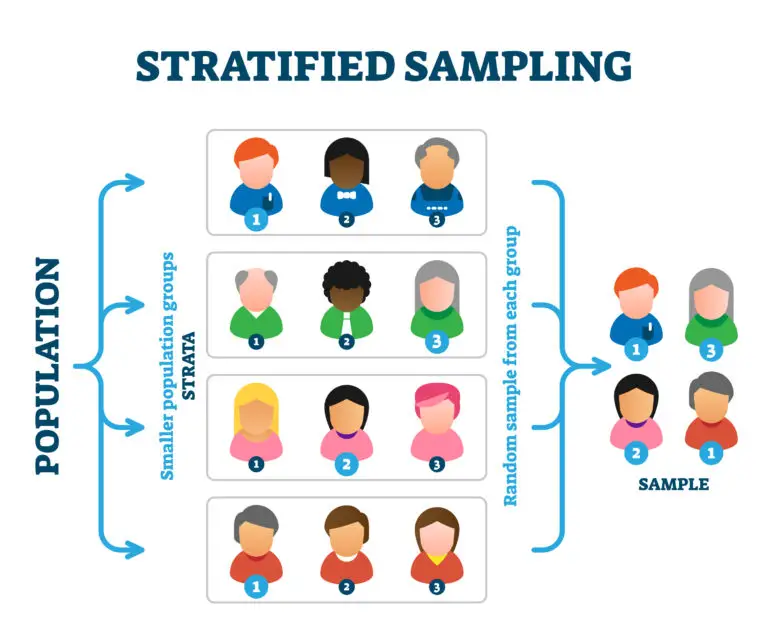Stratified Random Sample

Table of Contents
Stratified Random Sample Definition
A stratified random sample is a sampling method where the population is divided into distinct subgroups or strata based on certain characteristics. Then, a random sample is taken from each stratum.
This technique ensures that each subgroup is adequately represented in the sample, making it particularly useful when the population exhibits heterogeneity or variability in key characteristics.
Stratification
- The population is divided into non-overlapping strata or subgroups based on a relevant characteristic, such as age, gender, income level, geographic region, or any other variable of interest.
- Each stratum should be internally homogenous (similar characteristics within the stratum) but may differ from other strata in terms of the characteristic being used for stratification.
Random Sampling within Strata
- Once the population is stratified, a random sample is independently selected from each stratum. This ensures that each stratum is represented in the sample proportionally to the size of the population.
- Random sampling methods, such as simple or systematic random sampling, can be used within each stratum to select the sample.
Proportionate and Disproportionate Sampling
- In proportionate stratified random sampling, the sample size from each stratum is proportional to the size of the stratum in the population. For example, if a stratum constitutes 20% of the population, 20% of the sample will be drawn from that stratum.
- In disproportionate stratified random sampling, different sample sizes are allocated to each stratum based on research priorities, the variability within strata, or the desired precision for estimates from each stratum.
Advantages
- Improved Precision: Stratified random sampling can increase precision and efficiency compared to simple random sampling, especially when significant differences or variability exist between strata.
- Representation: Each subgroup or stratum is represented in the sample, allowing for more accurate estimates and generalizability of results to the entire population.
- Control over Subgroups: Researchers can ensure that important subgroups are adequately represented in the sample, even if they are relatively small in the overall population.
Limitations
- Requires Knowledge of Strata: Proper implementation of stratified random sampling requires accurate knowledge of the population’s characteristics and the ability to define meaningful and distinct strata.
- Complexity: Stratified random sampling can be more complex to design and implement compared to simple random sampling, especially when dealing with multiple strata and varying sample sizes.
Stratified Sampling Example
Imagine a company wanting to survey to gather product feedback from customers across different age groups. The company’s target population consists of all customers who have purchased their products in the past year, and they want to ensure that the survey represents the diverse age demographics of their customer base.
To achieve this, the company decides to use stratified random sampling. Here’s how they might implement it:
Define Strata: The company divides its customer population into age groups: 18-30 years, 31-50 years, and over 50 years.
Determine Sample Sizes: The company determines the desired sample sizes for each stratum based on the proportion of customers in each age group. For example:
- 18-30 years: 200 customers
- 31-50 years: 150 customers
- Over 50 years: 100 customers
Randomly Select Samples: The company uses random sampling techniques within each age group to select the specified number of customers. This ensures that each customer within a stratum has an equal chance of being selected.
Contact Selected Customers: The company reaches out to randomly selected customers from each age group and invites them to participate in the product feedback survey. They provide necessary information about the survey’s purpose, confidentiality, and how to complete it.
Collect and Analyze Data: Customers who agree to participate complete the survey, providing feedback on various aspects of the company’s products. The company collects and analyzes the data, stratifying the results by age groups to compare feedback across different demographics.
Using stratified random sampling, the company ensures that the survey sample represents the age diversity within its customer base. This method allows for more precise customer feedback analysis within each age group while providing insights into overall trends and patterns across the entire customer population.
Related Links
Convenience Sampling
Simple Random Sample
Snowball Sampling
Voluntary Sampling